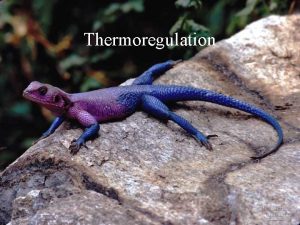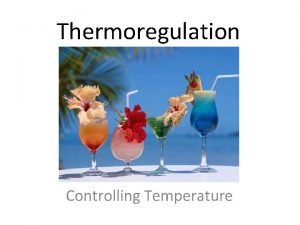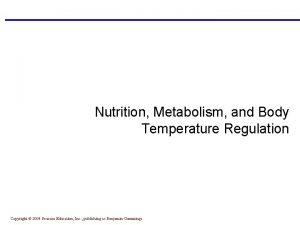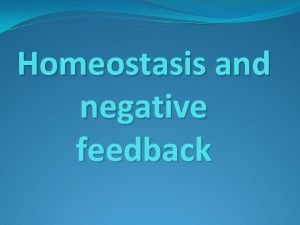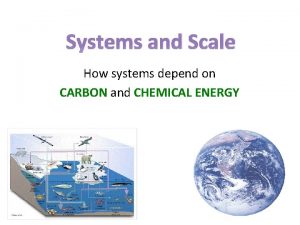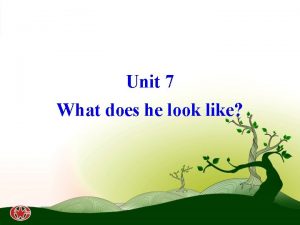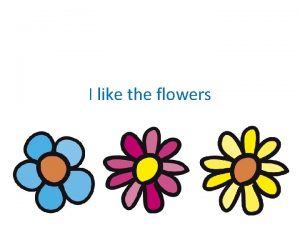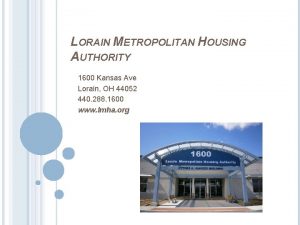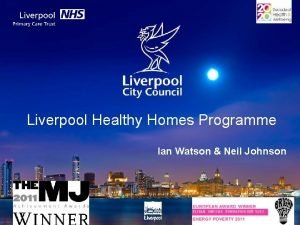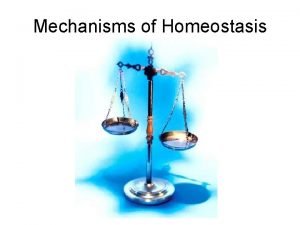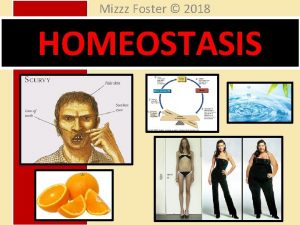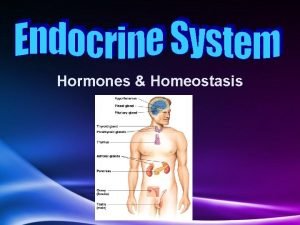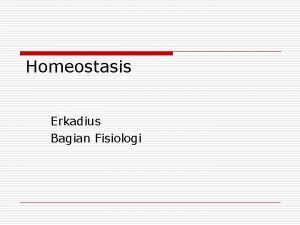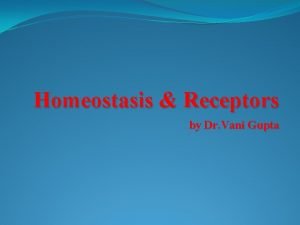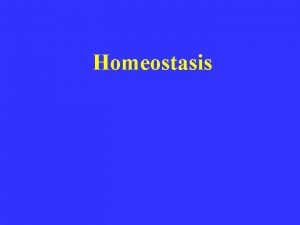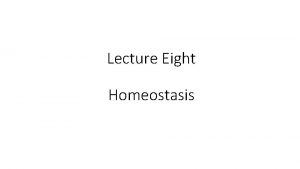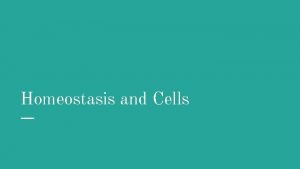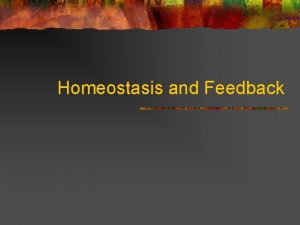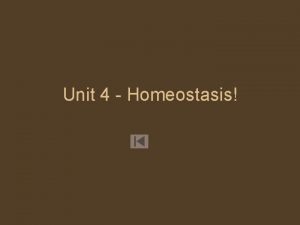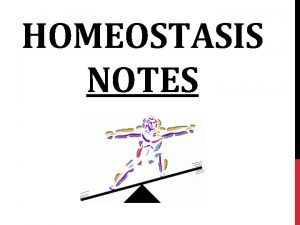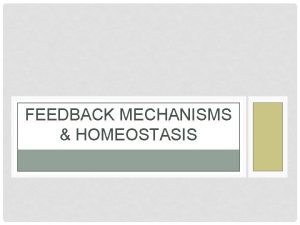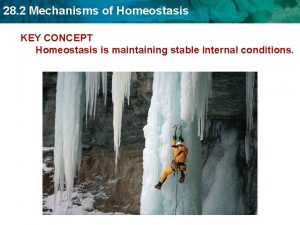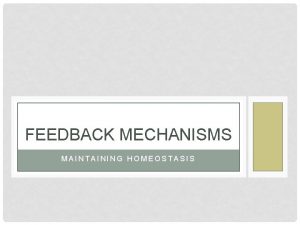Mechanisms of Homeostasis Homeostasis is like your homes



























- Slides: 27

Mechanisms of Homeostasis

Homeostasis is like your home’s thermostat Thermostat’s set point is 75ºF heat Inside temperature = 72ºF 75ºF 74ºF 73ºF

• Defined: Process where the body maintains a constant internal environment • Importance: Internal reactions & enzymes work best in specific conditions • Control systems adjust to internal/external changes • Changes controlled: p. H, temp, fluids

Control Systems • Sensors (aka: receptors) – Gather information about the body and environment – Ex: skin senses pressure • Communication Center – Messages sent throughout the body to respond – Ex: Impulse travel through your nerves • Control Center – Receives information from the sensors – Ex: Brain interprets the impulse • Targets – Body part that changes its activity – Ex: Muscles in foot stretch/contract abruptly !*%!? %&#

Negative Feedback Loops • Regulates most of the body • Reverses any change that moves conditions from a set point – Ex: if your temp drops…you will shiver to generate heat 96. 8 97. 2 97. 5 97. 7 98. 1 98. 4 98. 6

Negative Feedback Loops • Regulates most of the body • Reverses any change that moves conditions from a set point – Ex: if your temp drops…you will shiver to generate heat – Ex: If your temp rises…you will sweat to cool down 100. 1 99. 7 99. 5 99. 2 98. 8 98. 6

Negative Feedback Loop: Cold Response

Negative Feedback Loop: Breathing

Positive Feedback Loop • Increases the changes away from set points • Important when rapid change is needed • Ex: Pregnancy contractions – Uterus contractions begin slowly – Oxytocin released to speed up the contractions Negative Ask yourself… feedback would reverse and stop So how will the body respond to the If the this contractions. was negative feedback, if the feedback? contractions what would contractions if it’s. But positive happen next? stopped, would the baby be delivered?

Working Together • Thermoregulation: Maintenance of body temperature – Skin: sensors detect cold – Nervous system: electrical impulse sent to brain – Endocrine system: releases hormones into blood stream – Muscles: Hormones cause shivering

Homeostasis disruption • Some disruptions temporary – Infections, fever, sore throats, muscle soreness • Some disruptions too great for your body to control – Frost bite: Sensors are destroyed – Paralysis: Messages from brain doesn’t reach target Beck Weathers, thought to be dead, survived a night exposed to Mt. Everest cold.

Normal Insulin Production • Cells needs glucose • Mitochondria uses glucose to make ATP energy • After meals, glucose levels in the blood increase cell cell Blood cell

Normal Insulin Production • Cells needs glucose • Mitochondria uses glucose to make ATP energy • After meals, glucose levels in the blood increase cell G G G G cell G Alert! Blood High blood sugar G cell G

Normal Insulin Production • But the channels (doors) that allow glucose into your cells are closed • Your pancreas responds by releasing insulin into the blood stream closed cell G G G G cell G Alert! Blood High blood sugar G cell G

Normal Insulin Production • But the channels (doors) that allow glucose into your cells are closed • Your pancreas responds by releasing insulin into the blood stream cell G G G G cell G Alert! Blood High blood sugar G cell G

Normal Insulin Production • Insulin causes the channels (doors) to open • Glucose diffuses into the cells, giving them much needed nutrition cell cell i i i G G G Alert! Blood High blood sugar G G G i i i cell cell G

Normal Insulin Production • Insulin causes the channels (doors) to open • Glucose diffuses into the cells, giving them much needed nutrition • Glucose level in blood returns to normal cell cell i i i G G G Alert! Blood High blood sugar G G G i i i cell cell G

Diabetes • Cells needs glucose • Mitochondria uses glucose to make ATP energy • After meals, glucose levels in the blood increase cell cell Blood cell

Diabetes • Cells needs glucose • Mitochondria uses glucose to make ATP energy • After meals, glucose levels in the blood increase cell G G G G cell G Alert! Blood High blood sugar G cell G

Diabetes • But the channels (doors) that allow glucose into your cells are closed • A damaged pancreas will often release too little insulin cell G G G G cell G Alert! Blood High blood sugar G cell G

Diabetes • But the channels (doors) that allow glucose into your cells are closed • A damaged pancreas will often release too little insulin cell G G G G cell G Alert! Blood High blood sugar G cell G

Diabetes • But the channels (doors) that allow glucose into your cells are closed • A damaged pancreas will often release too little insulin • Reduced insulin causes only a few channels (doors) to open cell cell i G G G Alert! Blood High blood sugar G G G i cell cell G

Diabetes • Very little glucose can diffuse into the cells • The glucose level in the blood never returns to normal • Hours later, the next meal adds even more glucose cell cell i G G G Alert! Blood High blood sugar G G G i cell cell G

Diabetes • Very little glucose can diffuse into the cells • The glucose level in the blood never returns to normal • Hours later, the next meal adds even more glucose cell G cell i G G G G cell G G G i cell G G G G Alert! Blood G G G High blood sugar G G G cell

Diabetes • Ironically, the cells begin to starve even though food is nearby • The blood becomes acidic • Negative effects: heart disease, high blood pressure, stroke, death cell G cell i G G G G cell G G G i cell G G G Alert! Blood G G High blood sugar G G G cell G G G

Diabetes Treatment • Insulin injections • Insulin causes the channels to open and allows glucose to enter the cells ii iiii i cell G cell i G G G G cell G G G i cell G G G Blood G G cell G G G cell G G G

Review 1) 2) 3) 4) 5) Define homeostasis. Name and describe the four parts of the “control system. ” What is negative feedback? What is positive feedback? Is the following example positive or negative feedback? During heavy exercise your body loses water when you sweat. As a result of water loss, your body redirects the remaining water inside your body to vital parts of your body to replenish these vital organs. 6) What is diabetes? 7) Which organ releases insulin? 8) What happens when glucose levels are too high in the blood?
 Homeostasis mechanisms for regulation of body temperature
Homeostasis mechanisms for regulation of body temperature Body temperature maintenance
Body temperature maintenance Thermoregulation
Thermoregulation Negative feedback loop
Negative feedback loop Bioflix activity homeostasis hormones and homeostasis
Bioflix activity homeostasis hormones and homeostasis Bioflix activity homeostasis hormones and homeostasis
Bioflix activity homeostasis hormones and homeostasis Give us your hungry your tired your poor
Give us your hungry your tired your poor Would rather negative examples
Would rather negative examples Remo ualberta login
Remo ualberta login Which features of the sun look like huge cloudlike arches?
Which features of the sun look like huge cloudlike arches? Why does ethanol look like water but behave more like wood?
Why does ethanol look like water but behave more like wood? Like minds like mine
Like minds like mine What does he look like
What does he look like What does he look like
What does he look like I like the flowers boomwhackers
I like the flowers boomwhackers Ambiguities definition
Ambiguities definition Which is worse, stealing like karl or cheating like bob
Which is worse, stealing like karl or cheating like bob Like father like son in spanish
Like father like son in spanish Kw luxury homes international
Kw luxury homes international Qapi template for nursing homes
Qapi template for nursing homes Caneye taino house
Caneye taino house What games did the tainos play
What games did the tainos play St vincents housing association
St vincents housing association Rent to own homes tahlequah ok
Rent to own homes tahlequah ok Eastern woodlands clothes
Eastern woodlands clothes Labana developers llp
Labana developers llp Lorain metropolitan housing
Lorain metropolitan housing Healthy homes liverpool
Healthy homes liverpool
